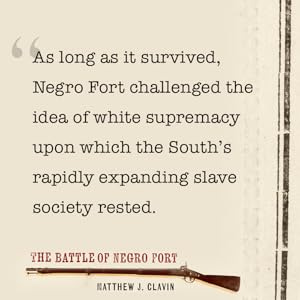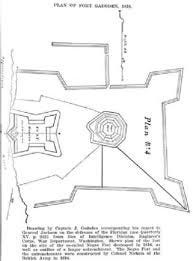The Negro Fort (1816) – A Bastion of Black Resistance
Black History Through the Lens of Liberation
To those who built sanctuary from nothing.
To those who fortified their freedom with stone, gunpowder, and unwavering resolve.
To those who dared to live free—and fought to keep it that way.
This is the story of Negro Fort, the forgotten stronghold of self-liberated Black people, where freedom was not requested—it was claimed.
It is a story of rebellion, sovereignty, and the lengths to which white supremacy has always gone to destroy Black independence.
And it is a story that demands to be remembered.
A Fortress of Freedom on Stolen Land
By 1816, the United States was barely 40 years old, and already, it was clear:
Black freedom was an act of war in the eyes of America.
After the War of 1812, (June 18, 1812–February 17, 1815), conflict fought between the United States and Great Britain over British violations of U.S. maritime rights. It ended with the exchange of ratifications of the Treaty of Ghent.)the British abandoned a well-armed fort on the banks of the Apalachicola River in Spanish-controlled Florida. Self-liberated Black men and women, along with Seminoles and other Indigenous allies, moved in and made it their own.
They took the weapons left behind.
They took the land.
They took the opportunity to build something for themselves.
And just like that, Negro Fort became the largest free Black settlement in the South, filled with escaped enslaved people, freedmen, and those who refused to live under American rule.
They farmed, they built, and they prepared to defend what was theirs.
But America could not let that stand.
The Fear of Black Sovereignty
Let’s be clear: Negro Fort wasn’t just a threat to white supremacy because it existed.
It was a beacon.
It was proof that Black people, when given the chance, would not just survive—but thrive.
It was a reminder that slavery was not natural, not inevitable, not unchallenged.
It was inspiration for those still in chains to rise up and claim their freedom.
And America could not allow that idea to spread.
The U.S. government—under Andrew Jackson’s expansionist vision—saw the fort as a direct challenge to white power.
They claimed it was a base for "criminals."
They claimed it was a haven for "runaways."
They claimed it was "dangerous."
But the only real danger was the possibility that freedom might become contagious.
So, in 1816, U.S. forces, aided by Creek warriors allied with the government, set out to wipe Negro Fort off the map.
Massacre at Negro Fort
The attack was swift, brutal, and deliberate.
The U.S. sent gunboats down the Apalachicola River, surrounding the fort.
Inside, around 300 Black men, women, and children prepared to defend their home.
They refused to surrender.
And so, the Americans fired a single red-hot cannonball into the fort’s ammunition supply.
The explosion was catastrophic.
Negro Fort was instantly obliterated, killing more than 250 people in seconds.
Those who survived were re-enslaved, executed, or forced to flee deeper into Indigenous territories.
The message was clear: Black sovereignty would not be tolerated.
But the fight was far from over.
Beyond the Ruins: A Legacy of Resistance
Negro Fort was destroyed, but its spirit lived on in the resistance movements that followed:
The Seminole Wars (1817–1858), where Black and Indigenous warriors fought side by side against U.S. expansion.
The Exodusters Movement (1879), where Black families fled the South to establish their own towns.
The Black Panther Party (1966), where community defense once again became a revolutionary act.
History repeats.
But so does Black resilience.
Negro Fort was not just a battle—it was a lesson.
A lesson in what happens when Black people take control of their own destinies.
A lesson in how far America will go to suppress Black independence.
A lesson in why liberation can never be granted—it must be built and defended.
Reflection: What Forts Are We Building Today?
Negro Fort was a physical space, but its meaning is timeless.
Where are we creating spaces of Black safety today? Queer safety, disabled safety, and more?
Where are we reclaiming our own narratives, economies, and institutions?
How do we defend those spaces—without apology?
Because if history has taught us anything, it is this:
Black freedom must be fortified.
Further Learning: Watch, Read, and Experience
📺 Watch:
The African Americans: Many Rivers to Cross (PBS) – Chronicles Black resistance from slavery to the present.
The Seminole Wars: America’s Longest Indian Conflict – Examines the role of Black warriors in these battles.
📖 Read:
Slavery by Another Name by Douglas A. Blackmon – A deep dive into how Black people were re-enslaved after emancipation.
The Black Seminoles: History of a Freedom-Seeking People by Kenneth W. Porter – Explores the connection between Black freedom fighters and Indigenous resistance.
🎭 Experience:
Visit the Fort Gadsden Historic Site in Florida, where the remains of Negro Fort stand.
Research modern Black cooperative movements and community self-defense organizations.
A 28-Day Journey Through Black Resistance and Liberation
The story of Negro Fort is just one chapter in the long history of Black defiance.
It’s part of my 28-Day Journey Through Black Resistance and Liberation—a living document that continues to grow with new stories, new lessons, and new actions.
✊🏾 Join the journey today: Get the guide here
Conclusion: We Are the Fort
Negro Fort was not just about walls and weapons—it was about Black people choosing themselves.
It was about declaring, in an era of slavery, that we will live free, or die trying.
And that declaration still echoes today.
Every Black-owned business, every community safe haven, every mutual aid network, every school that teaches real history, every movement that refuses to bow to oppression—they are modern-day Negro Forts.
The U.S. destroyed one fort in 1816.
But we are still building, for us, for you, for ALL!
And this time, they will not tear us down.
In solidarity and liberation,
Desireé B. Stephens CPS-P
Educator | Counselor | Community Builder
Founder, Make Shi(f)t Happen





